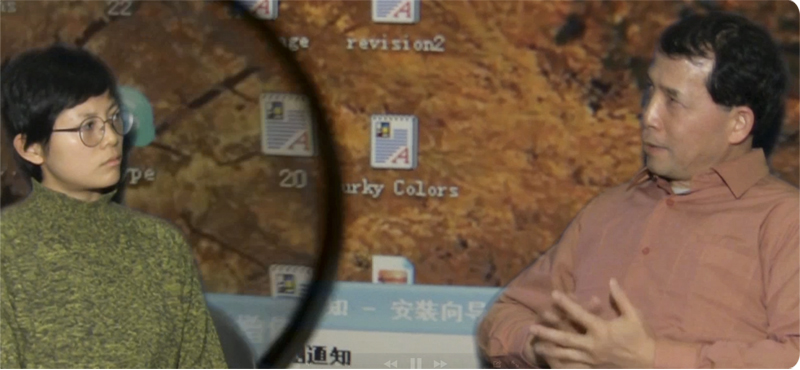The first time I ever watched Casey Wei’s Murky Colors (2013) was while I was looking at a sculpture by Patrick Cruz at Centre A. There were three small and obsolete monitors installed on a low platform addled with glitter and post-consumer offerings, wholly covered by Cruz’s maximalist paint treatment. (1) The monitors each showed a work by Dada Docot, Jac Phillipe V. Carpio or Casey Wei. I had gone to the exhibition with the intention to review it but I spent the majority of my time squatting in front of this sculpture watching Wei’s film. Cruz’s exhibition was very flashy and timely, a zealous display of the aestheticized debris of globalization and accelerated capitalism. Facilitating an ideal viewing experience was low on priority. In spite of the chaos, shitty headphones and sleepy limbs, Wei’s film remained with me long after I wrote the review and the exhibition closed.
The film, Murky Colors, is based on a made-for-hollywood spy novel by Menjin Wei, Wei’s father. It is not, by any measure, a conventional adaptation, however, it begins to chart the poetics of one. Wei’s editing approaches the arrangement of images with a writerly consideration by incorporating elements of the film essay and collage in her participatory documentary.
All characters in the recreation of Menjin Wei’s novel are played by Wei. Throughout the film, the action scenes are intercut with Wei interviewing her father, him reading from his manuscript, gonzo footage of their family trip to China, and Hollywood and Hong Kong action films. Her editing and post-production techniques amplify the tropes of spy movies and pulp novels. Scenes where Casey negotiates a drop (with herself), interrogates a suspect (herself), are done without an iota of irony and are convincing enough to make all the different characters and their contrasting moral agendas distinct. At times the Hollywood footage is edited in such a way that it fulfills the action that couldn’t be logistically shot with a one-woman cast.
Her post-production techniques with green screen and special effects purposefully expose the seams of film editing. The willful and genuine facture Wei advances by splicing a hotel scene from Murky Colors with footage of Daniel Craig’s Bond moving through their respective hotel rooms demonstrates an internalized spatial fluency with the movement through that space, that story. Genre films follow a formula we’ve been exposed to so many times, we could reproduce it like the lyrics of a Backstreet Boys song. We’ve seen this spy movie before — but not quite like this. There are moments of light agitprop, such as the political address layered over a CNN segment, or footage of a march against the Chinese Communist Party in Vancouver, narrated by Menjin Wei’s explanation of how corruption in China is parcel to emergent economic power. But Wei’s goal is not caricature or to dish up an underhanded, artful critique. The film’s plethora of crafted sequences with interludes of personal footage and popular media provoke us to reconsider how we might visualize the narratives we’re familiar with, and that they might still be legible, or illuminated when abutted to other forms of fiction or formal experimentation.
Bringing her father’s novel / unrealized spy movie into proximity with its past aspirations demonstrates something that I think all artists have the capacity to do with their work, yet so few rarely do. It recuperates a possibility that was lost in one context. In this case, the adaptation of Murky Colors, is revitalized in its own lifetime, and it pulls the rest of us into the chronology of an artwork. It’s not a grand statement, but universal in feeling. Menjin Wei narrates over footage of the dramatization of his novel, directed by and starring his daughter who intercuts the story with footage of car chases and a family trip. Is this the adaptation he thought he would get? I think it’s astronomically better.
Murky Colors screened with her second film Vater und Sohn/Father and Son/父与子 (2014). This screening was programmed as part of the exhibition, sum of the parts at 221A, curated by Jenn Jackson and taking place at The Cinematheque on May 22, 2018.
- Bulaklak ng Paraiso (Birds of Paradise) at Centre A in 2016. Curated by Makiko Hara


